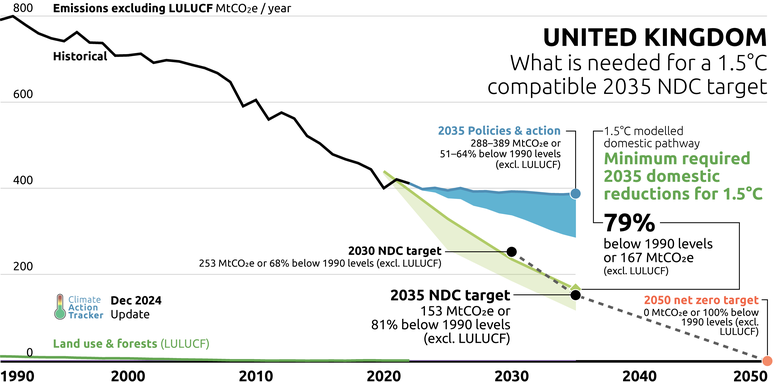2035 NDC
2035 NDC Target Overview
The UK’s 2035 target in its new NDC is ambitious and would translate to emissions below our cost-effective 1.5ºC modelled domestic pathway (MDP). Given that the 2035 target can also be reasonably achieved from the 2030 target, we label the UK’s new NDC as “1.5°C compatible” against MDPs. We welcome this proposed emissions cut for 2035 on the road to reaching net zero GHG emissions by 2050 and it is the first developed country to get this assessment.
At the same time, some key issues should be highlighted:
- First, the UK should still revise and align its 2030 emissions target with 1.5ºC compatible modelled domestic pathways. The UK’s current 2030 climate target of a 68% reduction below 1990 levels is very close to the 70% cut needed to align with these pathways. In 2023, UK emissions were estimated to already be 53% below 1990 levels. Updating the 2030 target could be key in encouraging and motivating other countries to revisit and update their targets also.
- Second, the UK should consider going beyond the minimum targets set by MDPs which are a floor, not a ceiling of ambition.
- While this 2035 target aligns with cost-effective pathways limiting warming to 1.5ºC, the UK’s fair share of climate action goes far beyond what it does domestically. The UK should therefore increase the climate finance it provides for developing countries in order to facilitate substantial emission reductions internationally, and ultimately communicate this as part of its final NDC.
- What matters most is action to reduce emissions in the real economy. The new government has inherited a vast implementation gap, with existing policies covering only 24% of the emission reductions needed to meet the new 2035 target. Urgent action will be needed to introduce, strengthen and implement policy mechanisms that turn this new ambition into reality.
- The UK should not be developing new oil and gas resources and needs to progress its phase out of fossil fuels beyond coal. Leadership is badly needed on this issue globally and it is very bad signal if the UK follows the US Trump Administration on this issue.
The UK submitted its 2035 NDC mitigation target on 30 January 2025 setting a target to cut emissions to 81% below 1990 levels by 2035 keeping the same headline ambition that it announced at COP29. This target covers all sectors and all gases. With its 2035 target of 153 MtCO2e, the UK has closed the gap between its target and our 1.5°C compatible MDP in 2035 and gone slightly below the threshold of 167 MtCO2e excluding emissions from land use, land use change and forestry (LULUCF).
| United Kingdom | 2035 NDC Target | ||
|---|---|---|---|
| 2035 unconditional NDC target | |||
|---|---|---|---|
| Formulation of target in NDC | [81% below 1990 levels by 2035 (incl. LULUCF) | ||
| Absolute emissions level in 2035 excl. LULUCF |
153 MtCO2e [81% below 1990] [75% below 2010] |
||
| Status | Submitted on 30 January 2025 | ||
Ambition
For the world to have a significant chance of limiting warming to 1.5˚C, governments must switch to emergency mode and strengthen both their 2030 targets and current policies to include substantial emissions cuts and significantly contribute to closing the 2030 emission gap. The UK’s submitted 2035 NDC target did not increase the ambition of its 2030 target.
2030 NDC Target
| 2030 unconditional NDC target | ||
|---|---|---|
|
Is the target 1.5°C compatible against modelled domestic pathways? |
|
|
|
Is the target 1.5°C compatible against fair share? |
|
|
|
Is this a stronger target? |
|
|
2035 NDC Target
| 2035 unconditional NDC target | ||
|---|---|---|
|
Is the target 1.5°C compatible against modelled domestic pathways? |
|
|
|
Does the NDC include sectoral targets? |
|
|
|
Does the NDC include a renewable energy capacity target? |
|
|
|
Does the target align with the country’s net-zero pathway? |
|
|
The UK’s 2035 target is in the right ballpark for a cost-effective path to 1.5ºC. There’s also good detail on the current policy mix being implemented to cut emissions. We have the destination, and we have the tools to get there. What we now need is a detailed roadmap, breaking down sector by sector what the UK’s targets will be to achieve these emissions reductions. An updated net zero strategy will be published in “due course”, with full detail of policy packages across all sectors. The CAT is ready and waiting to evaluate this when it emerges.
The submitted NDC of 153 MtCO2e in 2035 is 1.5°C compatible against modelled domestic pathways because it is slightly below the 1.5°C compatible threshold of 167 MtCO2e excluding LULUCF, however, the UK's its 2030 target of 253 MtCO2e is still slightly above the 236 MtCO2e threshold for 1.5°C MDP excluding LULUCF.
The 2035 NDC target includes detail on the actions being taken in different sectors to reduce emissions. This includes a commitment to end new oil and gas licensing, to achieve at least 95% clean power by 2030, and to accelerate the rollout of electric vehicles via the Zero Emissions Vehicle policy. These plans align with the UK’s commitments under the Global Stocktake (GST).
The UK’s target for clean power appears broadly compatible with the CAT’s own power sector benchmarks, which found that, to align with the Paris Agreement, the UK would need to reduce gas to 2–4% of the electricity mix by 2030 and cut this further by 2035 (Climate Action Tracker, 2023).
Further information on the UK’s net zero target can be found here.
Fairness & Finance
Developed countries need to significantly scale up international climate finance and other means of support. Developed countries should set domestic mitigation targets in their NDCs that are at least aligned with globally cost-effective 1.5ºC pathways, and should communicate the financial and other support they will provide to developing countries. Developing countries should clearly communicate the climate finance they need to set and achieve ambitious 1.5°C aligned conditional targets.
| 2035 unconditional NDC target | ||
|---|---|---|
|
Does the target clearly communicate the climate finance contributions and other support to be provided and mobilised to other countries? |
|
|
Our methodology makes it clear that developed countries should set NDC targets that are at least compatible with their 1.5°C modelled domestic pathways and should meet these targets within their own borders and using their own resources. The UK’s submitted 2035 NDC is 1.5°C compatible against modelled domestic pathways.
Developed countries are also expected to complement their ambitious domestic mitigation efforts with significant financial support for mitigation in other countries. The UK has communicated that it intends to honour the commitment made by the previous government to spend GBP 11.6bn between 2021 and 2026, with at least GBP 3bn of this going to nature. This will be challenging, due to the systemic underspending on climate finance between 2021–2024, but is a welcome confirmation.
The UK then needs to commit to an ambitious climate finance goal for post-2026, as its 2030 and 2035 NDCs do not align with its fair share of global mitigation, and its provision of finance is currently rated as “Highly Insufficient."
Credibility
Credible NDCs should build on robust national planning processes that translate the economy-wide emissions reduction target into action in all sectors. Governments need to ramp up the implementation of their existing targets and further develop policies to close the huge emissions gap between current policies and a 1.5°C pathway. Contradictory policies must be addressed and reversed: fossil fuel production needs to be phased out, while fossil fuel exploration and fossil fuel subsidies need to stop.
| 2035 unconditional NDC target | ||
|---|---|---|
|
Is the target aligned with current policies and driving more ambitious action? |
|
|
|
Does the NDC reference national planning processes for its development? |
|
|
|
Does the NDC reference an institutional framework/plan in place for its implementation? |
|
|
|
Does the target commit to phase out fossil fuel production? |
|
|
|
Does the target commit to stop fossil fuel exploration & subsidies? |
|
|
The UK’s NDC fits within its institutional framework for planning, delivering and monitoring emission reductions. As such, it is a broadly credible document which demonstrates how planning and monitoring can help deliver on the commitments made.
However, planning and monitoring can only get you so far. Ultimately what is needed is action, and fast. The UK government inherited a vast implementation gap from the previous administration, with only 24–32% of the emissions cuts needed to meet the UK’s NDC covered by credible policy (CCC, 2024). While the Government has made steps in addressing this, much more will need to be done.
Transparency
Governments should set absolute, economy wide, emission reduction target trajectories including all GHG gases, specifying the emissions levels for each year as an absolute level of emissions (excluding LULUCF) so they are clear, transparent, and immune to creative accounting. NDC targets should primarily focus on their domestic reductions by decarbonising all sectors of the economy rather than relying on forestry sinks, other carbon dioxide removal (CDR) or international carbon markets.
| 2035 unconditional NDC target | ||
|---|---|---|
|
Is the target based on fixed, absolute values? |
|
|
|
Does the target cover all sectors? |
|
|
|
Does the target cover all greenhouse gases? |
|
|
|
Does the target specify an emissions pathway? |
|
|
|
Does the target separate out land use and forestry? |
|
|
|
Does the target separate out other CO2 removal by type? |
|
|
|
Does the target separate out the use of carbon credits? (Article 6) |
|
|
The UK has often been a leader in the transparency of its communications to the UNFCCC. While this NDC provides a large amount of detail, the UK has missed the opportunity to provide clarity in three key areas: LULUCF, carbon removal, and carbon credits. The UK’s LULUCF emissions are very small compared to total emissions (at less than 1% of total emissions in 2022), and so the lack of clarity on LULUCF is perhaps less of an issue.
However, the UK has been criticised for relying too heavily on carbon dioxide removal in its long-term strategy and net-zero targets. In this context, clarity on how much CO2 removal the government is banking on for its 2035 NDC would have been helpful. A clear commitment to not rely on carbon credits would also have been welcome, even if the UK has already stated that it “does not intend” to use them.
For more information, on the UK’s climate targets and policies, please click here. For the CAT’s full recommendations for setting NDC targets that form the basis of the analysis above, please click here.
References
CCC. (2024). Progress in reducing emissions: 2024 Report to Parliament. www.theccc.org.uk/publications
Climate Action Tracker. (2023). Clean electricity within a generation: Paris-aligned benchmarks for the power sector. https://climateactiontracker.org/documents/1159/CAT_2023-09-19_Briefing_ParisBenchmarks_PowerSector.pdf
Further analysis
Latest publications
Stay informed
Subscribe to our newsletter





